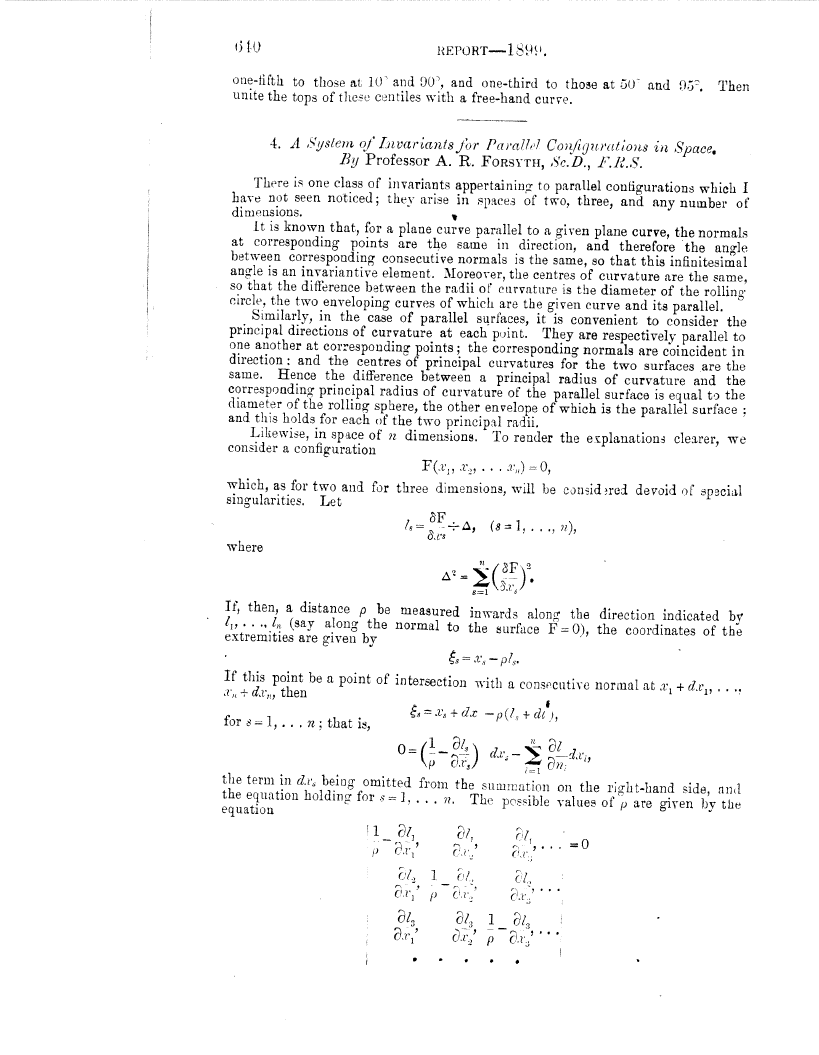OCR Rendition - approximatefj 10 REPORT--ISU0.
one-fifth to those at IU' and 90', and one-third to those at 50- and ii)3 Then unite the tops of these centiles with a free-hand curve.
4. A Siyslein ql' invarianls Jor Paraiiel Configurations in Space, By Professor A. R. FoRs Tx, Sc.D., F.R.S.
There is one class of invariants appertaining to parallel configurations which I have not seen noticed; they arise in spaces of two, three, and any number of dimensions. f
It is known that, for a plane curve parallel to a given plane curve, the normals at corresponding points are the same in direction, and therefore the angle between corresponding consecutive normals is the same, so that this infinitesimal angle is an invariantive element. Moreover, the centres of curvature are the same, so that the difference between the radii of curvature is the diameter of the rolling circle, the two enveloping curves of which are the given curve and its parallel.
Similarly, in the case of parallel surfaces, it is convenient to consider the principal directions of curvature at each point. They are respectively parallel to one another at corresponding points ; the corresponding normals are coincident in direction ; and the centres of principal curvatures for the two surfaces are the same. Hence the difference between a principal radius of curvature and the corresponding principal radius of curvature of the parallel surface is equal to the diameter of the rolling sphere, the other envelope of which is the parallel surface and this holds for each of the two principal radii.
Likewise, in space of n dimensions. To render the explanations clearer, we consider a configuration
F(.2'„ .v xn)=0,
which, as for two and for three dimensions, will be consid gyred devoid of special singularities. Let
1,= BF-O,
6, CS
where
s=1
$s=x,-p1,.
If this point be a point of intersection with a consecutive normal at x, + d.ci,....
X" + dx,,, then i
& =x,+dx -p (1,+de i,
If, then, a distance p be measured 1„ ..., l,, (say along the normal to extremities are given by
inwards along the direction indicated be the surface F=0), the coordinates of the
for ~ = 1, . . . n ; that is,
i=1
the term in d.r, being omitted from the summation the equation holding for •s = l .... n. The possible equation
0 a43 ?z ~
- (1--„4 a1 1a'r,
- \ p x,) Cl
Ct n
on the right-hand side, and values of p are given by the
I C~1, C'1 C1
=0
( .2't C
01~ Si3 1 _ ~1,
,
Gl.ri P
|

